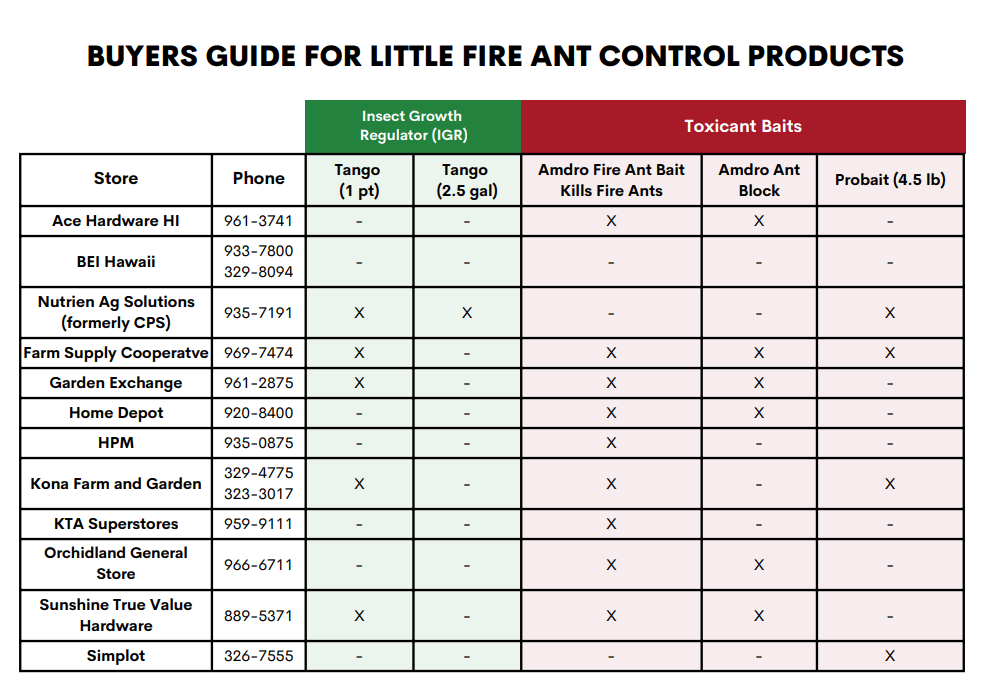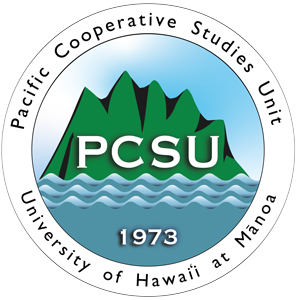
Little Fire Ants
History & Impacts
The Little Fire Ant (Wasmannia auropunctata) is known by many names around the world, including cocoa-tree ant, little red fire ant, or electric ant (because stings have been compared to the feeling of an electrical burn). It is native to South America but has invaded tropical and sub-tropical regions around the world from Africa to Israel to Australia to the Galapagos Islands. It is even known as a greenhouse pest in colder areas such as Europe and Canada! LFA can be transported easily through many kinds of personal and commercial cargo.
Through DNA studies, we can see that the LFA we have in Hawai‛i are most closely related to invasive colonies in Florida. It is thought that they were accidentally introduced to Hawai‛i Island on shipments of plants to nurseries in Puna sometime in the 1990s. LFA are listed among the world’s 100 worst invasive species. They are easily transported on cars, building materials, and plant materials.


Photos (L-R): Zach Pezzillo, Alex Wild
Surveying
It is important to survey your property when bringing in new plants/materials, if you suspect LFA on your property, or if neighboring properties have an LFA infestation. LFA are tiny and can be living on your property unnoticed. Their invasion only becomes apparent when their numbers increase so much that you start getting stung while working in the yard, or even in your own home! The sooner you can catch LFA trying to move in the easier they are to treat. Surveying is extremely simple.

Smear a thin layer of peanut butter on the edge of the chopstick and place them in shady areas throughout your property. When surveying the border, place one chopstick about every 10 feet. Focus on “hot spots”: places like the crooks of tree branches, compost or greenwaste piles piles, rock walls, weed mat/plastic, debris, and pots. LFA like to nest in shady moist areas and can make a nest in practically anything.
The best times to survey (and bait) are in the early morning or in the late afternoon when it’s not too hot. Leave the peanut butter sticks out for 30 minutes to 1 hour. When collecting place any sticks with ants in a zipper plastic bag and place them in the freezer for 24 hours to kill them.
If this is the first time surveying and you want to confirm if the ants you collected are LFA bring/mail your dead samples to:
- The Hawaii Ant Lab at the Department of Agriculture, 16 E Lanikaula St, Hilo HI 96720 (also accepts samples by mail. Just make sure to also include contact info)
- Big Island Invasive Species Committee 23 E Kawili St, Hilo HI 96720 Next to the Department of Land and Natural Resources Division of Forestry and Wildlife.
Controlling Little Fire Ants
There are many products which claim to be for fire ants. However, there are many different species of fire ants in the world, and not all products will work on all species! Little fire ants do not build mounds and they live in supercolonies with many queens. These nests all work together and can span large areas from treetops to rock walls. Their unique ecology requires a special approach to treatment in Hawai‛i. BIISC relies on the results of years of scientific tests from University researchers at the Hawai‛i Ant Lab and Cooperative Extension service to inform our recommendations for treatment of LFA on Hawai‛i Island.
There are multiple products that are effective in treating LFA. However, the most important thing to keep in mind is that there is no one-step method to eradicating an LFA infestation. Colonies can recover after a single application, so any effective plan will involve multiple applications. Whatever bait product you choose, plan to treat your property with a bait product every 4-6 weeks for a year in order to wipe out all of the nests!
There are several different types of products that you can use to control LFA. Your personal plan will depend on your landscape, amount of area, and type/amount of vegetation. Be sure to carefully read all the label requirements of any product you choose to use.
Treat with a bait product
Ant baits are disguised as attractive food, encouraging the worker ants to share the pesticide with the rest of the colony, including queens and developing larvae. You can choose between two types of baits: toxicant baits or insect growth regulators.

Please note while all of these products are safe for mammals and birds, they are not approved for use in all types of vegetation (for instance, some are not labeled for use in fruit trees, while others may be labeled for use in avocado or citrus trees only). These products have a short shelf life and become ineffective three months after opening. Apply only on dry days, you only need 4-6 hours of dry weather for it to be effective. Please read the label to ensure you have the right product for your landscape.
Below are some examples of granular toxicant baits:





*Antixx and Firefighter have short shelf lives even with closed. Make sure it hasn’t been 1 year past the manufacture date*

Unlike toxicants, IGRs don’t kill the pests, but disrupt their life cycle. These products reduce or stop the egg production of queens, and prevent eggs and larvae from developing, thus weakening the colony. IGRs are not poison and will not kill adult workers (these are the ones that sting). Since IGRs have no impact on non-reproductive ants, the product will take some time to take effect: workers have a lifespan of about 3-4 months, and the impacts will be seen once the workers start to die off. IGRs contain the active ingredients methoprene. Tango (methoprene) has been approved to be mixed into the gel bait developed by HAL. Tango bait recipe cards.
Tango gel bait is good for areas with lots of fruit trees, as it is labeled to use on/around food crops. One gallon of bait will generally treat 1 acre (you may go up to 2 gal/acre for areas with heavy vegetation). Tango is recommended to begin your treatment, as several months will weaken the colony and make it vulnerable to a later toxicant regimen.


Barrier treatments can be used when you have infestations occurring on neighboring properties or stretches of land where control is not taking place. You may want to spray around the base of your house and all entryways to prevent ants from coming into your house, while you are also baiting the ants outside in your yard to get rid of the colonies.
Do not apply a barrier treatment and bait at the same time in your yard! The barrier may prevent workers from reaching the bait or keep them from returning to the colony, which would be a waste of time and money for you. It’s best to use a barrier treatment once your infestation is under control. If you are using a barrier around your house to prevent ants form coming inside, do not apply on the same day as you bait.
This is the type of product used by pest control companies who spray to prevent ants from entering or forming colonies inside your home. If you would prefer to apply these treatments yourself, know that they come as a granular or a liquid. Unlike bait products, these granulars must be mixed with water to be effective. Products may contain the active ingredients bifenthrin, cyfluthrin, and cypermethrin. Some examples of barrier treatments are:
Contact Pesticides:
Substances like Raid, Sevin, and Orange Guard fall into this category. These are made to kill a wide range of insects and bugs, which includes beneficial insects if they also come in contact with the spray. These pesticides are only a short-term fix, and are mainly used for keeping ants out of a certain area. Using contact pesticides will not kill the colony, only the ants that come in contact with the spray. These are best used in the house where you just need to get rid of the few that are biting you. Baiting is the only sure way to eliminate little fire ants.
Quarantine
LFA are great hitchhikers. This means that they can easily travel around with our stuff. Whenever you bring something to your home from an LFA-infested area you should quarantine it.
With barrier products:
- Apply barrier product to a flat area. Wait to dry.
- Place the object to quarantine in the sprayed area.
- Check for ants using a chopstick and peanut butter. Wait 1 hour, check for ants.
- If ants are found, return the product or treat the ants with a granular toxicant bait. Keep in the barrier until there are ants no longer found by a peanut butter test.
- When there are no ants, remove the product from quarantine.
With soapy water (only for small objects):
- Fill a container with water and and small amount of dish soap.
- Use an emtpy upside down container to create an ‘island’ within the larger container.
- Place the object on the ‘island’.
- Check for ants using a chopstick and peanut butter. Wait 1 hour, check for ants.
- If ants are found, return the product or treat the ants with a granular toxicant bait. Keep in quarantine until there are ants no longer found by a peanut butter test. Make sure to refil soapy water as needed.
- When there are no ants, remove the product from quarantine.




